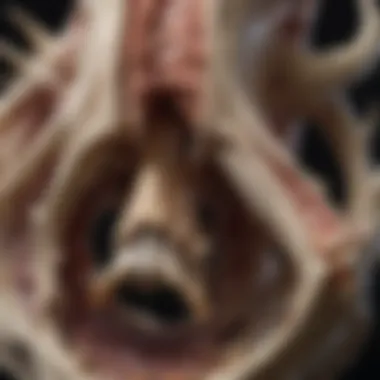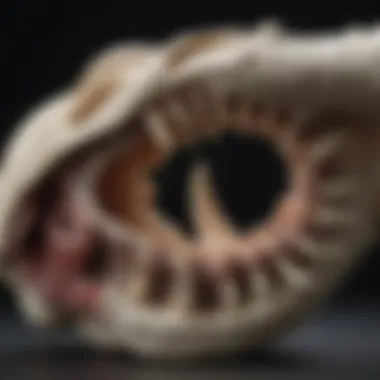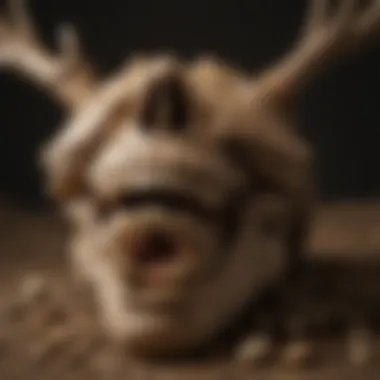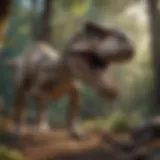The Enigmatic Universe of Deer Mandible Unveiled: An In-Depth Exploration


Rock and Fossil Identification
Deer mandibles, intricate structures renowned for their evolutionary significance and ecological role, embody a captivating realm awaiting exploration. Understanding the characteristics of these mandibles delves into the essence of their anatomy and adaptations. Through a meticulous examination of deer mandibles, researchers and enthusiasts can unravel the intricacies of their composition, shedding light on the significance of these fascinating skeletal elements in the broader context of deer evolution.
Envision the convergence of rock and fossil identification techniques when delving into the study of deer mandibles. While rocks encompass various types such as sedimentary, igneous, and metamorphic, fossils offer a glimpse into the past evolution of these majestic creatures. The characteristics to look for in deer mandibles range from size and shape to detailed structures like teeth and articulations. Analyzing these features requires specialized tools such as calipers, magnifiers, and dental picks to ensure precise identification and differentiation.
Collecting Tips and Techniques
Embarking on a quest to collect deer mandibles demands a strategic approach infused with best practices and care. Locating prime collecting sites entails exploring diverse habitats where deer thrive, from lush forests to vast grasslands. When extracting specimens, it's crucial to prioritize ethical considerations and respect for the environment, ensuring the sustainable collection of these precious artifacts. Employing techniques like sifting through soil and carefully excavating skeletal remains enhance the collecting experience, fostering a genuine appreciation for the archaeological and paleontological significance of deer mandibles.
Preservation and Display
Preserving deer mandibles transcends mere conservation efforts; it encapsulates a harmonious blend of science and creativity. Utilizing preservation techniques like cleaning, drying, and storing in controlled environments safeguards these skeletal treasures from degradation. Proper storage methods involve archival materials like acid-free paper and storage boxes, ensuring long-term protection and integrity. For creative display ideas, envision showcasing deer mandibles in themed collections or museum exhibits, captivating audiences with the allure of these enigmatic skeletal structures.
Geological Insights
Linking deer mandibles to geological insights unveils a tapestry of interconnected narratives, spanning geological formations, historical significance, and remarkable discoveries. Tracing the origins of rocks and fossils associated with deer mandibles leads to a deeper appreciation of geological processes and time scales. The historical significance of these specimens resonates with the rich tapestry of evolutionary history, portraying the intricate interplay between earth's geological narrative and the enigmatic world of deer mandibles. Notable discoveries in the field serve as milestones in understanding deer evolution, highlighting the ongoing quest to unlock the secrets held within these ancient relics.
Introduction to Deer Mandible
In the vast landscape of wildlife anatomy, the deer mandible stands out as a crucial element worth deep exploration. Understanding the intricacies of the deer mandible not only offers valuable insights into the evolutionary journey of these majestic creatures but also unravels the ecological significance they hold within their ecosystems. Within this article, we embark on a comprehensive journey delving into the fundamental aspects of deer mandibles to illuminate their importance and shed light on their enigmatic world.
Understanding the Anatomy
Mandible Structure
Delving into the realm of the mandible structure unveils a complex system designed with precision to support various functions critical for the deer's sustenance and survival. The robustness and adaptability inherent in the mandible structure play a monumental role in facilitating chewing and mastication processes essential for a herbivorous diet. Its unique osseous composition and articulation with the skull ensure efficient biomechanics during feeding, highlighting its evolutionary perfection in aiding the deer's survival. Despite its strength, the mandible structure also harbors vulnerabilities, particularly in aging individuals or those subjected to environmental stressors, accentuating the need for meticulous observation and care in research and conservation efforts.
Tooth Morphology
The intricacies of tooth morphology within deer mandibles serve as a testament to the evolutionary adaptations honed over millennia. From the specialized dentition designed for efficient grinding of fibrous vegetation to the regenerative capabilities that ensure continual sustenance, tooth morphology stands as a cornerstone in the deer's evolutionary success. The unique cusps and elongated shape of deer teeth reflect a harmonious coevolution with their ecosystem's flora, emphasizing the intricate balance forged through time. Despite the resilience embedded in their dental architecture, challenges such as dental diseases or wear patterns showcase the delicate equilibrium between adaptation and vulnerability in deer populations, signaling a need for comprehensive dental health studies to safeguard their well-being.
Articular Processes
Articular processes integrated within the deer mandible epitomize the mechanics behind jaw movement and leverage crucial for diverse functional activities. The articulation between the mandible and cranium via these processes allows for seamless movements necessary for grazing, alert behaviors, and vocalizations pivotal in the deer's survival strategies. The adaptability of these articular processes to accommodate varying pressures during feeding or aggressive interactions elucidates their pivotal role in sustaining the deer's existence in dynamic habitats. However, any damage or malformation within these articular components can disrupt essential functions, underscoring the importance of detailed anatomical analyses and conservation measures to foster healthy deer populations thriving in their natural environments.
Ecological Role of Deer Mandibles
Deer mandibles play a pivotal role in the intricate web of ecosystems, shaping the dynamics of flora and fauna interactions. By focusing on the ecological role of deer mandibles within this article, we unravel the critical interconnectedness they have with their environment. Their feeding behavior, foraging strategies, and food processing mechanisms showcase how deer mandibles influence ecosystem equilibrium and biodiversity. Understanding the ecological nuances of deer mandibles is essential to comprehend their profound impact on the natural world.


Feeding Behavior
Herbivorous Diet
Delving into the herbivorous diet of deer sheds light on their primary source of nutrition, emphasizing the cellulose-rich vegetation they consume. This dietary choice is not just a preference but a biological necessity, highlighting the specialized digestive adaptations that enable deer to efficiently extract nutrients from plant matter. The unique feature of their herbivorous diet lies in the fermentation chambers within their stomachs, aiding in breaking down tough plant fibers. While advantageous for sustaining deer populations, reliance solely on plant-based diets can present challenges during seasons of limited forage availability.
Foraging Strategies
Exploring deer's foraging strategies reveals the versatility and adaptability in their feeding behaviors. Their ability to alternate between browsing, grazing, and selective feeding based on seasonal food availability showcases a dynamic foraging approach. The key characteristic of deer's foraging strategies is their role in ecosystem maintenance through influencing plant growth patterns and diversity. Despite the benefits of such flexibility, specific foraging strategies may also lead to habitat disruptions or overgrazing in managed lands, necessitating conservation interventions.
Food Processing
The intricate food processing mechanisms employed by deer highlight their physiological adaptations for efficient nutrient extraction. Dental adaptations, such as hypsodont teeth and dental batteries, facilitate the breakdown of fibrous plant material during mastication. This unique feature allows deer to maximize the utilization of plant resources while minimizing digestive workload. However, the extensive processing of abrasive plant material can lead to dental wear and dental health issues over time, emphasizing the delicate balance between feeding efficiency and oral health in deer populations.
Interaction with the Environment
Impact on Ecosystem
Deer's impact on ecosystems extends beyond their feeding habits to shaping vegetation dynamics and biodiversity. Their browsing activities can influence plant species composition and distribution, particularly in forested habitats. The key characteristic of deer's impact on ecosystems lies in their role as both consumers and ecosystem engineers, modulating plant communities through selective browsing preferences. While essential for maintaining ecological balance, unchecked deer populations can exert significant pressure on native plants, affecting ecosystem resilience.
Role in Trophic Dynamics
Examining deer's role in trophic dynamics unveils their position in the food web and the intricate relationships within ecosystems. As primary consumers, deer regulate plant populations, which subsequently impacts herbivore and predator abundance. The key characteristic of their trophic role is the cascading effects of deer abundance on various trophic levels, highlighting their indirect influence on community structure. However, fluctuations in deer populations can lead to imbalances in trophic interactions, necessitating nuanced management strategies for ecosystem stability.
Habitat Influence
The habitat influence of deer encompasses their behavioral responses to environmental cues and resource availability. Deer exhibit habitat selection patterns based on forage quality, cover availability, and seasonal variations. The key characteristic of habitat influence lies in the spatial distribution of deer populations and their utilization of diverse habitats for foraging, resting, and breeding. While deer play a crucial role in shaping habitat structure through browsing and bedding behaviors, human-induced habitat modifications can disrupt these natural patterns, leading to conflicts between wildlife conservation and land management practices.
Medical and Forensic Applications
In the context of this intricate exploration of deer mandibles, the section on Medical and Forensic Applications delves into the crucial intersection between these skeletal structures and the fields of medicine and forensic science. By unraveling the significance of deer mandibles in medical and forensic contexts, this article sheds light on their multifaceted utility.
Forensic Analysis
Identification Techniques
In the realm of Forensic Analysis, Identification Techniques play a pivotal role in discerning key information from deer mandibles. Their meticulous application aids in identifying specific deer species, ages, and potential pathologies. The utilization of Identification Techniques enhances the overall understanding of deer mandibles' characteristics, providing valuable insights for research and forensic investigations. The distinctive feature of these techniques lies in their ability to accurately pinpoint intricate details that might otherwise go unnoticed, thereby contributing significantly to the depth of analysis in this article.
Trauma Assessment
Another critical aspect within Forensic Analysis is Trauma Assessment, which offers invaluable insights into potential injuries or traumatic events associated with deer mandibles. By evaluating trauma markers and patterns present on the mandibles, forensic experts can reconstruct past events and elucidate the impact of various factors on deer populations. The key significance of Trauma Assessment lies in its ability to provide a detailed understanding of the trauma history associated with each mandible, aiding in accurate interpretations and conclusions within this article.


Age Estimation
Age Estimation emerges as a key component in Forensic Analysis, allowing researchers to derive essential information regarding the age of deer specimens based on mandible characteristics. By analysing growth patterns, wear factors, and developmental indicators, age estimation techniques enable a comprehensive understanding of the life stage and developmental history of deer populations. The unique feature of Age Estimation techniques lies in their precision and versatility in determining age-related information from deer mandibles, enriching the depth of analysis in this article.
Medical Insights
The realm of Medical Insights offers a profound understanding of the implications of deer mandibles in medical contexts, emphasizing their significance in diagnosing pathologies, assessing dental health, and informing surgical considerations.
Pathological Conditions
One pivotal aspect within Medical Insights is the examination of Pathological Conditions manifested in deer mandibles. By scrutinizing abnormalities, lesions, or signs of disease, researchers can glean valuable insights into the health status and potentially prevalent conditions within deer populations. The key characteristic of Pathological Conditions lies in their diagnostic significance, providing essential markers for understanding the health dynamics of deer mandibles. Their unique feature lies in the ability to correlate pathological indicators with environmental factors, offering a comprehensive perspective within this article.
Dental Health Indicators
The evaluation of Dental Health Indicators within deer mandibles offers profound insights into the oral health status and dental pathology prevalent in deer populations. By analysing wear patterns, dental abnormalities, and tooth conditions, researchers can draw correlations between dental health indicators and overarching health trends among deer communities. The key characteristic of Dental Health Indicators underscores their diagnostic value, serving as essential markers for assessing dental well-being within deer populations. The unique feature of these indicators lies in their ability to provide nuanced information on dental health, enhancing the medical insights presented in this article.
Surgical Considerations
Surgical Considerations represent a crucial aspect of medical perspectives on deer mandibles, encompassing the considerations and challenges faced in surgical interventions involving these skeletal structures. Whether in the context of wildlife conservation or paleontological research, understanding the surgical implications of deer mandibles is paramount for ensuring effective procedures and interventions. The key characteristic of Surgical Considerations lies in their interdisciplinary nature, bridging medical expertise with the unique anatomical nuances of deer mandibles. Their unique feature resides in the critical insights they offer for surgical planning and decision-making, enriching the medical narrative within this article.
Conservation Implications
In the realm of deer mandibles, the topic of conservation implications holds a pivotal role in ensuring the sustainability and well-being of deer populations. Conservation efforts are crucial for preserving biodiversity, maintaining ecosystem balance, and safeguarding these majestic creatures for future generations. Within the context of this article, exploring the significance of conservation implications sheds light on the interconnected relationship between humans and wildlife.
Deer Population Management
Hunting Regulations
Delving into the realm of hunting regulations unveils a crucial aspect of deer population management. These regulations serve as a fundamental tool in controlling deer populations, ensuring ecological harmony, and mitigating human-wildlife conflicts. The implementation of hunting regulations plays a key role in managing population densities, preventing habitat degradation, and promoting species coexistence. The effectiveness of hunting regulations lies in their ability to provide sustainable solutions for maintaining healthy deer populations and regulating ecosystem dynamics.
Habitat Conservation
The conservation of deer habitats stands as a cornerstone in promoting species survival and ecosystem resilience. Habitat conservation initiatives focus on preserving natural habitats, enhancing environmental quality, and fostering biodiversity conservation. By safeguarding deer habitats, conservationists work towards creating sustainable ecosystems where these animals can thrive and contribute to ecological balance. Habitat conservation efforts not only benefit deer populations but also support a wide array of flora and fauna, enriching the overall richness of natural landscapes.
Biodiversity Preservation
Biodiversity preservation plays a pivotal role in securing the intricate web of life in which deer mandibles are an integral part. By prioritizing biodiversity preservation, conservationists aim to protect the genetic diversity of deer populations, safeguarding against genetic bottlenecks and ensuring the resilience of ecosystems. Preserving biodiversity through targeted conservation strategies helps maintain the health and integrity of ecosystems, fostering sustainable living environments for deer and other wildlife species. The principles of biodiversity preservation align with the overarching goals of this article, emphasizing the importance of holistic conservation approaches for the long-term well-being of deer populations.
Human-Wildlife Conflict Resolution


Negotiating the complex landscape of human-wildlife conflicts requires strategic approaches and effective solutions to mitigate tensions and promote peaceful coexistence. Against this backdrop, initiatives such as mitigation strategies, coexistence programs, and community engagement emerge as key pillars in resolving conflicts and fostering harmonious relationships between humans and deer populations. Each element contributes uniquely to conflict resolution efforts, addressing various aspects of interaction dynamics and promoting a balanced approach towards sustainable cohabitation.
Mitigation Strategies
Mitigation strategies serve as proactive measures to minimize conflict occurrences, reduce negative interactions, and enhance landscape connectivity for wildlife movement. By implementing strategic interventions such as wildlife corridors, fencing solutions, and deterrent methods, stakeholders can effectively mitigate potential conflicts and promote safe spaces for both humans and wildlife. Emphasizing mitigation strategies within the context of this article underscores the importance of proactive conflict resolution measures as part of a broader framework for wildlife conservation and ecosystem management.
Coexistence Programs
Coexistence programs advocate for harmonious interactions between humans and wildlife, focusing on shared spaces, mutual respect, and collaborative conservation efforts. These programs aim to bridge communication gaps, foster understanding, and encourage adaptive cohabitation practices that benefit both communities and deer populations. Through coexistence programs, stakeholders can cultivate a sense of shared responsibility towards conservation, instilling notions of stewardship and environmental awareness within local communities.
Community Engagement
Engaging local communities in conservation initiatives plays a pivotal role in promoting positive attitudes towards wildlife, raising awareness about conservation challenges, and fostering stewardship ethics. Community engagement efforts seek to involve residents in conservation decision-making, outreach activities, and wildlife monitoring programs, creating a sense of ownership and responsibility towards the protection of deer populations and their habitats. By fostering community engagement, conservationists can leverage collective efforts to address conservation challenges, promote sustainable practices, and forge lasting partnerships for the benefit of both wildlife and humans.
Future Research Directions
Within the realm of deer mandibles, the discourse on future research avenues unveils a horizon ripe with innovative possibilities. Understanding the enigmatic world of deer mandibles requires a sharp focus on technological advancements that pave the way for groundbreaking discoveries. As we peer into the future, the trajectory of research in this field promises to be marked by unprecedented advancements.
Technological Advancements
3D Imaging Techniques
Visualizing the intricate structures of deer mandibles through cutting-edge 3D imaging techniques revolutionizes our exploration of their anatomy. The precision and depth offered by 3D imaging techniques enable a meticulous examination of mandibular features, shedding light on previously obscured details. This technology's unique capacity to render three-dimensional models enhances our comprehension of deer mandibles, providing a comprehensive framework for analysis within this article. Despite its advantages, challenges such as data processing complexity and equipment costs warrant consideration amidst its widespread adoption in this research domain.
Genetic Studies
Harnessing the power of genetic studies empowers researchers to delve deep into the evolutionary origins and developmental pathways of deer mandibles. By unraveling the genetic underpinnings influencing mandibular morphology, we can decipher the intricate interplay between genes and environmental factors in shaping mandibular diversity across species. The emphasis on genetic studies within this article underscores its role in elucidating complex biological processes, adding a layer of depth to our understanding of deer mandibles. However, genetic studies come with limitations in terms of ethical considerations and interpretational challenges that researchers need to navigate while leveraging this valuable tool in the study of mandibular evolution.
Bioinformatics Applications
The integration of bioinformatics applications amplifies the depth of analysis in exploring deer mandibles, bridging the gap between genetic data and phenotypic outcomes. By leveraging computational tools and algorithms, researchers can unravel the complexities of mandibular morphology with a systematic and data-driven approach. Bioinformatics applications serve as a cornerstone for data management, analysis, and visualization, elevating research capabilities within the domain of deer mandible studies. However, balancing the dependency on bioinformatics with traditional methodologies poses a notable consideration for researchers aiming to capitalize on its benefits effectively within the context of this article.
Interdisciplinary Studies
The intersection of various disciplines enriches our comprehension of deer mandibles, offering multifaceted insights that transcend conventional boundaries. Delving into interdisciplinary studies opens up a realm of possibilities for unraveling the nuanced dynamics underlying mandibular form and function. The synergy between diverse fields cultivates a holistic approach towards understanding deer mandibles, propelling forward a collaborative landscape ripe with innovation.
Biomechanical Analysis
Employing biomechanical analysis unveils the mechanical principles governing deer mandible functionality, providing a lens through which we can examine their adaptive evolution. By deciphering the biomechanical constraints influencing mandibular design, researchers can elucidate the functional efficiency and evolutionary trajectories of these intricate structures. The emphasis on biomechanical analysis within this article underscores its pivotal role in elucidating the adaptive strategies employed by deer mandibles across diverse ecological settings. However, the complex nature of biomechanical modeling and the need for robust validations present nuanced challenges in its application, necessitating a meticulous approach towards integrating biomechanical insights effectively.
Paleontological Correlations
Drawing parallels with paleontological data enables a deep dive into the historical narratives inscribed within deer mandibles, offering a temporal dimension to our understanding of their evolutionary journey. By juxtaposing contemporary observations with paleontological evidence, researchers can trace the evolutionary lineage of deer mandibles, contextualizing their anatomical adaptations within a broader timescale. The integration of paleontological correlations enriches the narrative woven around deer mandibles, infusing a sense of continuity and evolution into our exploration within this article. Nevertheless, reconciling discrepancies between fossil records and current findings poses a methodological challenge that researchers must navigate while intertwining paleontological perspectives with contemporary research insights.
Anthropological Insights
Unraveling the anthropological dimensions of deer mandibles unravels a tapestry of cultural and historical significance, shedding light on the intricate intersections between human interactions and natural history. By contextualizing deer mandibles within anthropological frameworks, researchers can delve into the symbolic, ritualistic, and utilitarian aspects that define human-deer relationships across diverse cultures. The exploration of anthropological insights within this article offers a cross-disciplinary perspective that transcends biological confines, highlighting the profound implications of deer mandibles beyond their biological utility. However, navigating the contextual nuances of anthropological interpretations poses interpretive challenges, necessitating a nuanced understanding of cultural contexts and historical legacies to unravel the full spectrum of anthropological insights encapsulated within deer mandibles.







